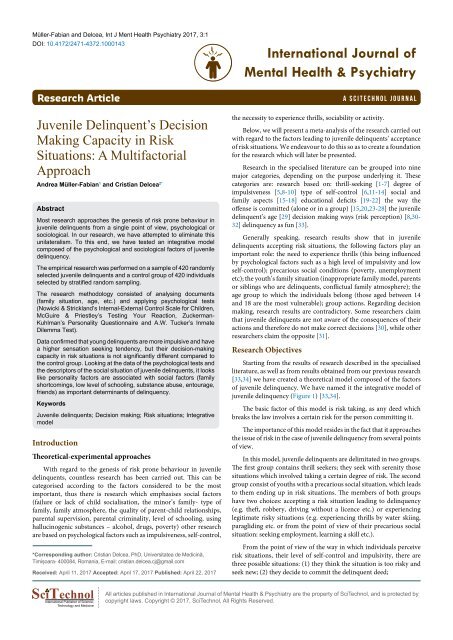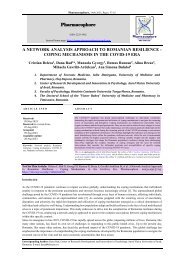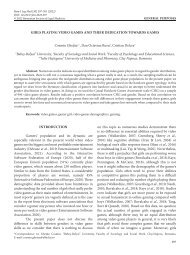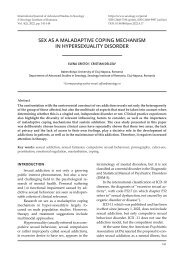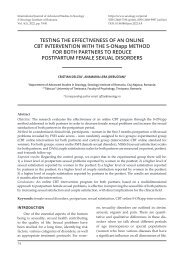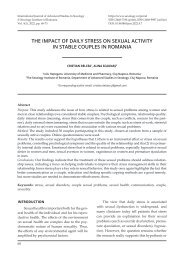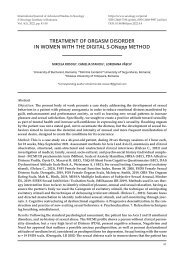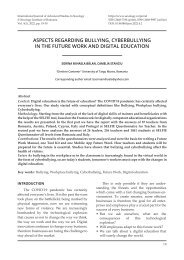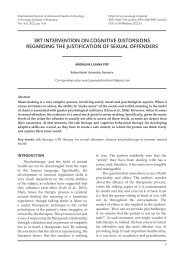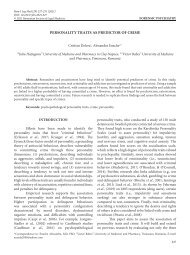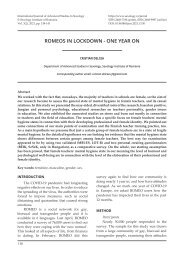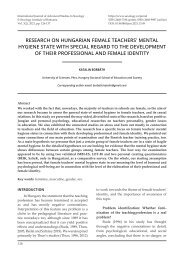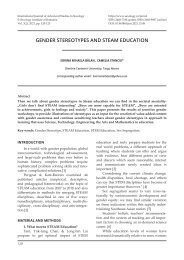Juvenile Delinquent’s Decision Making Capacity in Risk Situations: A Multifactorial Approach
Most research approaches the genesis of risk prone behaviour in juvenile delinquents from a single point of view, psychological or sociological. In our research, we have attempted to eliminate this unilateralism. To this end, we have tested an integrative model composed of the psychological and sociological factors of juvenile delinquency. The empirical research was performed on a sample of 420 randomly selected juvenile delinquents and a control group of 420 individuals selected by stratified random sampling. The research methodology consisted of analysing documents (family situation, age, etc.) and applying psychological tests (Nowicki & Strickland’s Internal-External Control Scale for Children, McGuire & Priestley’s Testing Your Reaction, Zuckerman- Kuhlman’s Personality Questionnaire and A.W. Tucker’s Inmate Dilemma Test). Data confirmed that young delinquents are more impulsive and have a higher sensation seeking tendency, but their decision-making capacity in risk situations is not significantly different compared to the control group. Looking at the data of the psychological tests and the descriptors of the social situation of juvenile delinquents, it looks like personality factors are associated with social factors (family shortcomings, low level of schooling, substance abuse, entourage, friends) as important determinants of delinquency.
Most research approaches the genesis of risk prone behaviour in
juvenile delinquents from a single point of view, psychological or
sociological. In our research, we have attempted to eliminate this
unilateralism. To this end, we have tested an integrative model
composed of the psychological and sociological factors of juvenile
delinquency.
The empirical research was performed on a sample of 420 randomly
selected juvenile delinquents and a control group of 420 individuals
selected by stratified random sampling.
The research methodology consisted of analysing documents
(family situation, age, etc.) and applying psychological tests
(Nowicki & Strickland’s Internal-External Control Scale for Children,
McGuire & Priestley’s Testing Your Reaction, Zuckerman-
Kuhlman’s Personality Questionnaire and A.W. Tucker’s Inmate
Dilemma Test).
Data confirmed that young delinquents are more impulsive and have
a higher sensation seeking tendency, but their decision-making
capacity in risk situations is not significantly different compared to
the control group. Looking at the data of the psychological tests and
the descriptors of the social situation of juvenile delinquents, it looks
like personality factors are associated with social factors (family
shortcomings, low level of schooling, substance abuse, entourage,
friends) as important determinants of delinquency.
- No tags were found...
Create successful ePaper yourself
Turn your PDF publications into a flip-book with our unique Google optimized e-Paper software.
Müller-Fabian and Delcea, Int J Ment Health Psychiatry 2017, 3:1<br />
DOI: 10.4172/2471-4372.1000143<br />
International Journal of<br />
Mental Health & Psychiatry<br />
Research Article<br />
a SciTechnol journal<br />
<strong>Juvenile</strong> <strong>Del<strong>in</strong>quent’s</strong> <strong>Decision</strong><br />
<strong>Mak<strong>in</strong>g</strong> <strong>Capacity</strong> <strong>in</strong> <strong>Risk</strong><br />
<strong>Situations</strong>: A <strong>Multifactorial</strong><br />
<strong>Approach</strong><br />
Andrea Müller-Fabian 1 and Cristian Delcea 2*<br />
Abstract<br />
Most research approaches the genesis of risk prone behaviour <strong>in</strong><br />
juvenile del<strong>in</strong>quents from a s<strong>in</strong>gle po<strong>in</strong>t of view, psychological or<br />
sociological. In our research, we have attempted to elim<strong>in</strong>ate this<br />
unilateralism. To this end, we have tested an <strong>in</strong>tegrative model<br />
composed of the psychological and sociological factors of juvenile<br />
del<strong>in</strong>quency.<br />
The empirical research was performed on a sample of 420 randomly<br />
selected juvenile del<strong>in</strong>quents and a control group of 420 <strong>in</strong>dividuals<br />
selected by stratified random sampl<strong>in</strong>g.<br />
The research methodology consisted of analys<strong>in</strong>g documents<br />
(family situation, age, etc.) and apply<strong>in</strong>g psychological tests<br />
(Nowicki & Strickland’s Internal-External Control Scale for Children,<br />
McGuire & Priestley’s Test<strong>in</strong>g Your Reaction, Zuckerman-<br />
Kuhlman’s Personality Questionnaire and A.W. Tucker’s Inmate<br />
Dilemma Test).<br />
Data confirmed that young del<strong>in</strong>quents are more impulsive and have<br />
a higher sensation seek<strong>in</strong>g tendency, but their decision-mak<strong>in</strong>g<br />
capacity <strong>in</strong> risk situations is not significantly different compared to<br />
the control group. Look<strong>in</strong>g at the data of the psychological tests and<br />
the descriptors of the social situation of juvenile del<strong>in</strong>quents, it looks<br />
like personality factors are associated with social factors (family<br />
shortcom<strong>in</strong>gs, low level of school<strong>in</strong>g, substance abuse, entourage,<br />
friends) as important determ<strong>in</strong>ants of del<strong>in</strong>quency.<br />
Keywords<br />
<strong>Juvenile</strong> del<strong>in</strong>quents; <strong>Decision</strong> mak<strong>in</strong>g; <strong>Risk</strong> situations; Integrative<br />
model<br />
Introduction<br />
Theoretical-experimental approaches<br />
With regard to the genesis of risk prone behaviour <strong>in</strong> juvenile<br />
del<strong>in</strong>quents, countless research has been carried out. This can be<br />
categorised accord<strong>in</strong>g to the factors considered to be the most<br />
important, thus there is research which emphasises social factors<br />
(failure or lack of child socialisation, the m<strong>in</strong>or’s family- type of<br />
family, family atmosphere, the quality of parent-child relationships,<br />
parental supervision, parental crim<strong>in</strong>ality, level of school<strong>in</strong>g, us<strong>in</strong>g<br />
halluc<strong>in</strong>ogenic substances – alcohol, drugs, poverty) other research<br />
are based on psychological factors such as impulsiveness, self-control,<br />
*Correspond<strong>in</strong>g author: Cristian Delcea, PhD, Universitatea de Medic<strong>in</strong>ă,<br />
Timișoara- 400084, Romania, E-mail: cristian.delcea.cj@gmail.com<br />
Received: April 11, 2017 Accepted: April 17, 2017 Published: April 22, 2017<br />
the necessity to experience thrills, sociability or activity.<br />
Below, we will present a meta-analysis of the research carried out<br />
with regard to the factors lead<strong>in</strong>g to juvenile del<strong>in</strong>quents’ acceptance<br />
of risk situations. We endeavour to do this so as to create a foundation<br />
for the research which will later be presented.<br />
Research <strong>in</strong> the specialised literature can be grouped <strong>in</strong>to n<strong>in</strong>e<br />
major categories, depend<strong>in</strong>g on the purpose underly<strong>in</strong>g it. These<br />
categories are: research based on: thrill-seek<strong>in</strong>g [1-7] degree of<br />
impulsiveness [5,8-10] type of self-control [6,11-14] social and<br />
family aspects [15-18] educational deficits [19-22] the way the<br />
offense is committed (alone or <strong>in</strong> a group) [15,20,23-28] the juvenile<br />
del<strong>in</strong>quent’s age [29] decision mak<strong>in</strong>g ways (risk perception) [8,30-<br />
32] del<strong>in</strong>quency as fun [33].<br />
Generally speak<strong>in</strong>g, research results show that <strong>in</strong> juvenile<br />
del<strong>in</strong>quents accept<strong>in</strong>g risk situations, the follow<strong>in</strong>g factors play an<br />
important role: the need to experience thrills (this be<strong>in</strong>g <strong>in</strong>fluenced<br />
by psychological factors such as a high level of impulsivity and low<br />
self-control); precarious social conditions (poverty, unemployment<br />
etc); the youth’s family situation (<strong>in</strong>appropriate family model, parents<br />
or sibl<strong>in</strong>gs who are del<strong>in</strong>quents, conflictual family atmosphere); the<br />
age group to which the <strong>in</strong>dividuals belong (those aged between 14<br />
and 18 are the most vulnerable); group actions. Regard<strong>in</strong>g decision<br />
mak<strong>in</strong>g, research results are contradictory. Some researchers claim<br />
that juvenile del<strong>in</strong>quents are not aware of the consequences of their<br />
actions and therefore do not make correct decisions [30], while other<br />
researchers claim the opposite [31].<br />
Research Objectives<br />
Start<strong>in</strong>g from the results of research described <strong>in</strong> the specialised<br />
literature, as well as from results obta<strong>in</strong>ed from our previous research<br />
[33,34] we have created a theoretical model composed of the factors<br />
of juvenile del<strong>in</strong>quency. We have named it the <strong>in</strong>tegrative model of<br />
juvenile del<strong>in</strong>quency (Figure 1) [33,34].<br />
The basic factor of this model is risk tak<strong>in</strong>g, as any deed which<br />
breaks the law <strong>in</strong>volves a certa<strong>in</strong> risk for the person committ<strong>in</strong>g it.<br />
The importance of this model resides <strong>in</strong> the fact that it approaches<br />
the issue of risk <strong>in</strong> the case of juvenile del<strong>in</strong>quency from several po<strong>in</strong>ts<br />
of view.<br />
In this model, juvenile del<strong>in</strong>quents are delimitated <strong>in</strong> two groups.<br />
The first group conta<strong>in</strong>s thrill seekers; they seek with serenity those<br />
situations which <strong>in</strong>volved tak<strong>in</strong>g a certa<strong>in</strong> degree of risk. The second<br />
group consist of youths with a precarious social situation, which leads<br />
to them end<strong>in</strong>g up <strong>in</strong> risk situations. The members of both groups<br />
have two choices: accept<strong>in</strong>g a risk situation lead<strong>in</strong>g to del<strong>in</strong>quency<br />
(e.g. theft, robbery, driv<strong>in</strong>g without a licence etc.) or experienc<strong>in</strong>g<br />
legitimate risky situations (e.g. experienc<strong>in</strong>g thrills by water ski<strong>in</strong>g,<br />
paraglid<strong>in</strong>g etc. or from the po<strong>in</strong>t of view of their precarious social<br />
situation: seek<strong>in</strong>g employment, learn<strong>in</strong>g a skill etc.).<br />
From the po<strong>in</strong>t of view of the way <strong>in</strong> which <strong>in</strong>dividuals perceive<br />
risk situations, their level of self-control and impulsivity, there are<br />
three possible situations: (1) they th<strong>in</strong>k the situation is too risky and<br />
seek new; (2) they decide to commit the del<strong>in</strong>quent deed;<br />
International Publisher of Science,<br />
Technology and Medic<strong>in</strong>e<br />
All articles published <strong>in</strong> International Journal of Mental Health & Psychiatry are the property of SciTechnol, and is protected by<br />
copyright laws. Copyright © 2017, SciTechnol, All Rights Reserved.
Citation: Müller-Fabian A, Delcea C (2017) <strong>Juvenile</strong> <strong>Del<strong>in</strong>quent’s</strong> <strong>Decision</strong> <strong>Mak<strong>in</strong>g</strong> <strong>Capacity</strong> <strong>in</strong> <strong>Risk</strong> <strong>Situations</strong>: A <strong>Multifactorial</strong> <strong>Approach</strong>. Int J Ment Health<br />
Psychiatry 3:1.<br />
doi: 10.4172/2471-4372.1000143<br />
MINORS/YOUNGSTERS<br />
Sensation<br />
seek<strong>in</strong>g<br />
Bad social<br />
conditions<br />
SOCIAL FACTORS<br />
SOCIAL FACTORS<br />
<strong>Risk</strong><br />
perception,<br />
self-control,<br />
impulsivity<br />
<strong>Risk</strong><br />
perception,<br />
self-control,<br />
impulsivity<br />
Look<strong>in</strong>g<br />
for a job<br />
Legal risky<br />
situations<br />
<strong>Juvenile</strong><br />
del<strong>in</strong>quents<br />
Legal<br />
activities<br />
Figure 1: The <strong>in</strong>tegrative model of juvenile del<strong>in</strong>quency (Müller-Fabian, 2015).<br />
(3) they adopt a different behaviour.<br />
If the youths cannot f<strong>in</strong>d or cannot afford legal situations meant<br />
to satisfy their thrill-seek<strong>in</strong>g needs, sooner or later they end up<br />
committ<strong>in</strong>g del<strong>in</strong>quent deeds.<br />
The purpose of this research is analys<strong>in</strong>g this model and, though<br />
this, outl<strong>in</strong><strong>in</strong>g the factors lead<strong>in</strong>g to juvenile del<strong>in</strong>quency. Accord<strong>in</strong>g<br />
to theories <strong>in</strong> the literature regard<strong>in</strong>g the factors of juvenile del<strong>in</strong>quency<br />
and the <strong>in</strong>tegrative model, we have formulated the follow<strong>in</strong>g general<br />
hypothesis: In the case of youths, accept<strong>in</strong>g risk situations lead<strong>in</strong>g to<br />
del<strong>in</strong>quency is caused both by social factors – type of family, family<br />
conditions, family atmosphere, parent-child relationships, degree of<br />
school<strong>in</strong>g, substance abuse, entourage, friends etc. – and by psychological<br />
factors, such as the need to experience thrills, level of impulsivity,<br />
sociability, activity and self-control. With regard to decision mak<strong>in</strong>g<br />
strategies, <strong>in</strong> a risk situation there is no difference between juvenile<br />
del<strong>in</strong>quents and non-del<strong>in</strong>quent <strong>in</strong>dividuals of the same age.<br />
The results of our research will underl<strong>in</strong>e the l<strong>in</strong>k between the<br />
factors mentioned above and the extent to which they <strong>in</strong>fluence the<br />
m<strong>in</strong>ors’ decision to get <strong>in</strong>volved <strong>in</strong> illegal risk situations, i.e. to choose<br />
to commit an offence.<br />
Method and Procedure<br />
Research population<br />
The sample <strong>in</strong>cluded 420 <strong>in</strong>mates from Gherla Maximum<br />
Security Penitentiary and Cluj External Branch (210 aged between<br />
14 and 18 and 210 aged between 19 and 21), randomly selected (a<br />
s<strong>in</strong>gle criterion was applied, namely age, keep<strong>in</strong>g the mark of the<br />
nonprobabilistic sample) and 420 <strong>in</strong>dividuals <strong>in</strong> the control group<br />
(210 aged between 14 and 18 and 210 aged between 19 and 21),<br />
selected by stratified random sampl<strong>in</strong>g.<br />
Research <strong>in</strong>struments<br />
The <strong>in</strong>struments used <strong>in</strong> our research were: Nowicki &<br />
Strickland’s Internal-External Control Scale for Children, McGuire<br />
& Priestley’s Test<strong>in</strong>g Your Reaction, Zuckerman-Kuhlman’s<br />
Personality Questionnaire and A.W. Tucker’s Inmate Dilemma Test<br />
and document analysis (the juvenile del<strong>in</strong>quents’ files).<br />
Research stages and the tested population<br />
The first stage consisted of file analysis. Thus, we had the<br />
opportunity to know the social situation of the juvenile del<strong>in</strong>quents.<br />
The second step of the research was apply<strong>in</strong>g the questionnaires on<br />
the control population. The items <strong>in</strong> our questionnaire corresponded<br />
with the questions <strong>in</strong> the files of the juvenile del<strong>in</strong>quents. The next<br />
step consisted of apply<strong>in</strong>g standardised questionnaires to both<br />
groups. The fourth step <strong>in</strong>volved apply<strong>in</strong>g the <strong>in</strong>mate’s dilemma on<br />
an imag<strong>in</strong>ary situation to both groups.<br />
Data process<strong>in</strong>g<br />
The research data was statistically processed us<strong>in</strong>g quantitative<br />
methods. The questionnaire results were processed us<strong>in</strong>g the t test<br />
and the χ 2 test, and if a significant correlation was found between<br />
Volume 3 • Issue 1 • 1000143<br />
• Page 2 of 5 •
Citation: Müller-Fabian A, Delcea C (2017) <strong>Juvenile</strong> <strong>Del<strong>in</strong>quent’s</strong> <strong>Decision</strong> <strong>Mak<strong>in</strong>g</strong> <strong>Capacity</strong> <strong>in</strong> <strong>Risk</strong> <strong>Situations</strong>: A <strong>Multifactorial</strong> <strong>Approach</strong>. Int J Ment Health<br />
Psychiatry 3:1.<br />
doi: 10.4172/2471-4372.1000143<br />
variables, we used the regression model to emphasise which of the<br />
variables had a bigger impact on the researched phenomenon. In<br />
order to apply the statistical methods mentioned above, we used the<br />
SPSS statistical software (Statistical Package for the Social Sciences).<br />
Results<br />
Results regard<strong>in</strong>g the social factors of juvenile del<strong>in</strong>quency<br />
After the statistical analyses of the data, we found differences<br />
between the del<strong>in</strong>quent group and the control group with regard to<br />
the follow<strong>in</strong>g variables: family conditions (Chi squared value: 155, 98;<br />
degree of significance 0,000), family atmosphere (Chi squared value:<br />
315, 70 degree of significance 0,000), relationship with parents (Chi<br />
squared value: 11, 2, significance: 0,001), be<strong>in</strong>g enrolled <strong>in</strong> a special<br />
needs or correctional school (Chi squared value:<br />
93, 15, significance: 0,000), hav<strong>in</strong>g been employed or not (Chi<br />
squared value: 84, 25, significance: 0,000), <strong>in</strong>tensity of alcohol<br />
consumption (Chi squared value: 104, 63, significance: 0,000).<br />
The youths who grew up <strong>in</strong> a balanced family (with an appropriate<br />
atmosphere, lov<strong>in</strong>g parents, good socialisers etc.) are less predisposed<br />
to del<strong>in</strong>quency than those who were not raised <strong>in</strong> such families (R<br />
squared is 46.8 %,). If the del<strong>in</strong>quent m<strong>in</strong>ors grew up <strong>in</strong> an appropriate<br />
family entourage, they committed fewer offenses (R squared is 13.2%).<br />
The reference group had a significant role <strong>in</strong> committ<strong>in</strong>g <strong>in</strong>fractions;<br />
thus, 31.6% of juvenile del<strong>in</strong>quents declared they had belonged to<br />
a group of del<strong>in</strong>quent friends. <strong>Juvenile</strong> del<strong>in</strong>quents who grew up<br />
<strong>in</strong> a family with an appropriate atmosphere, did not go to a special<br />
school and had been employed prior to committ<strong>in</strong>g the offense were<br />
imprisoned for a shorter period of time than the other del<strong>in</strong>quents (R<br />
squared is 7.6%).<br />
Results regard<strong>in</strong>g the psychological factors of juvenile del<strong>in</strong>quency<br />
Accord<strong>in</strong>g to our theoretical model, alongside social factors,<br />
psychological factors such as impulsiveness, sociability, selfcontrol,<br />
activity and thrill seek<strong>in</strong>g also play an important part <strong>in</strong> the<br />
<strong>in</strong>volvement <strong>in</strong> illegal risk situations (<strong>in</strong> committ<strong>in</strong>g offenses).<br />
In the case of psychological factors, we applied the t test <strong>in</strong> order<br />
to check whether there were differences between juvenile del<strong>in</strong>quents<br />
and the control group with regard to these factors (Table 1).<br />
The table shows that: <strong>in</strong> the case of juvenile del<strong>in</strong>quents, the<br />
level of self-control is significantly higher than <strong>in</strong> the case of the<br />
control group (t value: 19,03, degree of significance 0,000); juvenile<br />
del<strong>in</strong>quents are more impulsive (t value: 7,22, degree of significance:<br />
0,000) than non-del<strong>in</strong>quents; there is a difference <strong>in</strong> favour of<br />
del<strong>in</strong>quents with regard to thrill seek<strong>in</strong>g (t value: 19,00, degree of<br />
significance: 0,000) compared to the control group; <strong>in</strong> other words,<br />
juvenile del<strong>in</strong>quents are characterised to a larger extent by the desire<br />
to experience thrills; juvenile del<strong>in</strong>quents are more active (t value:<br />
6,40, degree of significance: 0,000) than non-del<strong>in</strong>quent youths<br />
and juvenile del<strong>in</strong>quents are less sociable (t value: -2,53, degree of<br />
significance: 0,011) than the members of the control group.<br />
Us<strong>in</strong>g the regression model we reached the follow<strong>in</strong>g results:<br />
thrill seek<strong>in</strong>g, self-control, impulsivity and activity are <strong>in</strong> a positive<br />
relationship with del<strong>in</strong>quency, while there is a negative relation<br />
between the sociability factor and del<strong>in</strong>quency (R squared is 43.4<br />
%,). In the case of a m<strong>in</strong>or del<strong>in</strong>quent, the higher his/her self-control,<br />
the more he/she will be characterised by thrill seek<strong>in</strong>g and the more<br />
sociable he/she is, the more offenses he/she will have committed (R<br />
squared is 7.7%). The period on imprisonment <strong>in</strong>creases with activity<br />
and sociability (R squared is 3.1%).<br />
<strong>Decision</strong>-mak<strong>in</strong>g capacity <strong>in</strong> risk situations<br />
<strong>Decision</strong> mak<strong>in</strong>g plays an important role <strong>in</strong> day to day life, as<br />
it ensures behaviour authenticity and coherence. We formulated<br />
our hypothesis so that we will be able to compare the decisions of<br />
juvenile del<strong>in</strong>quents with those of the non-del<strong>in</strong>quents. Apply<strong>in</strong>g<br />
the dilemma had the purpose of analys<strong>in</strong>g potential differences with<br />
regard to decision mak<strong>in</strong>g strategies <strong>in</strong> risk situations <strong>in</strong> the case of<br />
juvenile del<strong>in</strong>quents and non-del<strong>in</strong>quent youths of the same age.<br />
The number of <strong>in</strong>dividuals who chose the first option, namely<br />
“I confess noth<strong>in</strong>g” is almost equal for the two groups (308,<br />
301). However, a difference can be observed when it comes to the<br />
other options. It is <strong>in</strong>terest<strong>in</strong>g to note that double the number of<br />
del<strong>in</strong>quents opted for the last possibility, namely “I confess” (Table<br />
2). We are conv<strong>in</strong>ced that this answer is due to the situation they are<br />
<strong>in</strong> – <strong>in</strong>carcerated. This answer somehow reflects their “behavioural<br />
change for the better”.<br />
Only this table can illustrate whether there are differences with<br />
regard to decision mak<strong>in</strong>g strategies <strong>in</strong> the case of del<strong>in</strong>quents and<br />
non-del<strong>in</strong>quents. In order to f<strong>in</strong>d the answer to this question, we need<br />
a statistical analysis of the data obta<strong>in</strong>ed. This is why, for the next step<br />
we formulated the null hypothesis, namely “juvenile del<strong>in</strong>quents use<br />
different strategies for mak<strong>in</strong>g decisions <strong>in</strong> risk situations”. We used<br />
the χ 2 method <strong>in</strong> order to test the hypothesis (Table 3).<br />
S<strong>in</strong>ce the value obta<strong>in</strong>ed when apply<strong>in</strong>g the Chi-squared test is<br />
higher than the critical value, we can abandon the null hypothesis<br />
and can accept our <strong>in</strong>itial hypothesis, which states that differences <strong>in</strong><br />
decision mak<strong>in</strong>g strategies are <strong>in</strong>significant between the two groups<br />
studied. Therefore, we can claim that, <strong>in</strong> risk situations, juvenile<br />
del<strong>in</strong>quents adopt decision mak<strong>in</strong>g strategies similar to those of<br />
non-del<strong>in</strong>quent youths. Cognitive schemas, which play an important<br />
Table 1: Differences between the two groups with regard to psychological factors.<br />
Psychological factors Del<strong>in</strong>quent Average t. value df Significance<br />
Self-control Yes 17,28 19,03 838 0,000<br />
No 12,33<br />
Impulsivity Yes 19,17 7,22 838 0,000<br />
No 15,93<br />
Thrill seek<strong>in</strong>g Yes 9,62 19,00 838 0,000<br />
No 5,87<br />
Sociability Yes 7,67 -2,53 838 0,011<br />
No 8,08<br />
Activity Yes 11,33 6,40 838 0,000<br />
Volume 3 • Issue 1 • 1000143<br />
• Page 3 of 5 •
Citation: Müller-Fabian A, Delcea C (2017) <strong>Juvenile</strong> <strong>Del<strong>in</strong>quent’s</strong> <strong>Decision</strong> <strong>Mak<strong>in</strong>g</strong> <strong>Capacity</strong> <strong>in</strong> <strong>Risk</strong> <strong>Situations</strong>: A <strong>Multifactorial</strong> <strong>Approach</strong>. Int J Ment Health<br />
Psychiatry 3:1.<br />
doi: 10.4172/2471-4372.1000143<br />
Table 2: Answers obta<strong>in</strong>ed for the <strong>in</strong>mate’s dilemma.<br />
Del<strong>in</strong>quents Possible answers Total<br />
I confess We both The other I confess<br />
noth<strong>in</strong>g confess confesses<br />
Yes 308 14 7 91 420<br />
No 301 63 14 42 420<br />
Total 609 77 21 133 840<br />
Table 3: The result of the χ 2 test.<br />
Value Degree of freedom Significance<br />
Pearson 51,648 3 ,000<br />
χ 2<br />
Total 840<br />
df=3 , χ 2 =51,648, critical value=7,815 at p=0,05<br />
51,648>7,815<br />
part <strong>in</strong> decision mak<strong>in</strong>g, proved to be <strong>in</strong>dependent of whether the<br />
<strong>in</strong>dividual is a del<strong>in</strong>quent or not.<br />
Discussions and Conclusions<br />
Most research approaches the issue of juvenile del<strong>in</strong>quency from<br />
a s<strong>in</strong>gle po<strong>in</strong>t of view, be it sociological or psychological. In our<br />
research, we have attempted to elim<strong>in</strong>ate this unilateralism. To this<br />
end, we tested an <strong>in</strong>tegrative model, composed of the psychological<br />
and social factors of juvenile del<strong>in</strong>quency. We took <strong>in</strong>to account<br />
the psychological particularities of the m<strong>in</strong>or del<strong>in</strong>quent, such as<br />
impulsivity, thrill seek<strong>in</strong>g, which are known to <strong>in</strong>tervene <strong>in</strong> the<br />
del<strong>in</strong>quent’s risk tak<strong>in</strong>g behaviour; we also took <strong>in</strong>to consideration<br />
the level of self-control of the subjects, <strong>in</strong> order to underl<strong>in</strong>e its effect<br />
on tak<strong>in</strong>g risks. We also underl<strong>in</strong>ed those social particularities of<br />
the m<strong>in</strong>or del<strong>in</strong>quent about which – based on prior research – we<br />
supposed play a part <strong>in</strong> the del<strong>in</strong>quent’s tak<strong>in</strong>g risky decisions. As<br />
a last po<strong>in</strong>t <strong>in</strong> our research, we analysed the differences between<br />
juvenile del<strong>in</strong>quents and non-del<strong>in</strong>quent youths <strong>in</strong> risky situations,<br />
<strong>in</strong>vestigat<strong>in</strong>g decision-mak<strong>in</strong>g strategy.<br />
The results of our research emphasised the fact that, if the m<strong>in</strong>or<br />
has the psychological characteristics mentioned above (is impulsive<br />
by nature, active, sociable and a thrill-seeker) but does not have<br />
an appropriate family environment, not f<strong>in</strong>ancial security, is not<br />
educated as per the requirements perta<strong>in</strong><strong>in</strong>g to his/her age, becomes<br />
<strong>in</strong>volved <strong>in</strong> neighbourhood gang activity, which unites many crim<strong>in</strong>al<br />
youths, fulfils his/her more or less age-specific needs by committ<strong>in</strong>g<br />
illegal acts and ends up a juvenile del<strong>in</strong>quent.<br />
Follow<strong>in</strong>g our research, we can claim that the general hypothesis<br />
formulated by us is confirmed. In the case of youths, accept<strong>in</strong>g risk<br />
situations lead<strong>in</strong>g to del<strong>in</strong>quency is caused both by social factors –<br />
type of family, family conditions, family atmosphere, relationship<br />
with parents, level of school<strong>in</strong>g, us<strong>in</strong>g halluc<strong>in</strong>ogens, entourage,<br />
friends etc.) and psychological factors, such as the need to experience<br />
thrills, level of impulsivity, sociability, activity and self-control<br />
[35,36].<br />
At the same time, we hope that by our research we have once<br />
and for all broken the myth of the “un<strong>in</strong>formed” del<strong>in</strong>quent, who is<br />
not responsible for the deed committed due to difficulties <strong>in</strong> decision<br />
mak<strong>in</strong>g, cannot assess one’s deeds and become <strong>in</strong>volved <strong>in</strong> illegal<br />
situations without understand<strong>in</strong>g them. By test<strong>in</strong>g the potential<br />
differences with regard to decision mak<strong>in</strong>g strategies, both <strong>in</strong> the case<br />
of del<strong>in</strong>quent and non-del<strong>in</strong>quent youths, we reached the result that<br />
there are no differences between the two groups <strong>in</strong> this respect.<br />
References<br />
1. Eysenck HJ (1964) Crime and Personality. Houghton Miffl<strong>in</strong>, Boston,<br />
Massachusetts, USA.<br />
2. Zuckerman M (1971) Dimension of sensation seek<strong>in</strong>g. J. Consult. Cl<strong>in</strong>.<br />
Psychol 36: 45-52.<br />
3. Farley FH, Farley SV (1972) Stimulus-seek<strong>in</strong>g motivation and del<strong>in</strong>quent<br />
behaviour among <strong>in</strong>stitutionalized del<strong>in</strong>quent girls. J. Consult. Cl<strong>in</strong>. Psychol<br />
39: 94-97.<br />
4. West DJ, Farr<strong>in</strong>gton DP (1977) The Del<strong>in</strong>quent Way of Life. He<strong>in</strong>emann.<br />
Portsmouth. London.<br />
5. Farr<strong>in</strong>gton DP, Biron L, Leblanc M (1982) Personality and del<strong>in</strong>quency <strong>in</strong><br />
London and Montreal. Abnormal offenders, del<strong>in</strong>quency and the crim<strong>in</strong>al<br />
justice system. Wiley, New York, USA.<br />
6. Hampson SE, Severson HH, Burns WJ, Slovic P, Fisher KJ (2001) <strong>Risk</strong><br />
perception, personality factors and alcohol use among adolescents. Pers.<br />
Individ. Dif 30: 167-181.<br />
7. Khalafi A, Tangestani Y (2014) Comparative study of emotional <strong>in</strong>telligence<br />
and sensation seek<strong>in</strong>g <strong>in</strong> del<strong>in</strong>quent youths normal. JNASCI 3: 1228-1236.<br />
8. Donohew L, Zimmerman RS, Cupp PS, Novak S, Colon S, et al. (2000)<br />
Sensation seek<strong>in</strong>g, impulsive decision mak<strong>in</strong>g and risky sex: Implications for<br />
risk–tak<strong>in</strong>g and design of <strong>in</strong>terventions. Pers. Individ. Dif 28: 1079-1091<br />
9. Higg<strong>in</strong>s GE, Kirchner ELE, Marcum CD (2013) Impulsivity and Offend<strong>in</strong>g<br />
from Childhood to Young Adulthood <strong>in</strong> the United States: A Developmental<br />
Trajectory Analysis IJCJS 8: 182-197.<br />
10. Zimmermann, GM (2010) Impulsivity, Offend<strong>in</strong>g, and the Neighborhood.<br />
Investigat<strong>in</strong>g the Person–Context Nexus. J. Quant. Crim<strong>in</strong>ol 26: 301-332.<br />
11. Strickland LH, Lewicki RJ, Katz AM (1966) Temporal orientation and<br />
perceived control as determ<strong>in</strong>ates of risk tak<strong>in</strong>g. J. Exp. Soc. Psychol 2: 143-<br />
151.<br />
12. Gottfredson M, Hirschi T (1986) The True Value of Lambda Would Appear<br />
to Be Zero: An Essay on Career Crim<strong>in</strong>als, Crim<strong>in</strong>al Careers, Selective<br />
Incapacitation, Cohort Studies, and Related Topics. Crim<strong>in</strong>ology 24: 213-234.<br />
13. Reisig MD, Pratt TC (2011) Low Self-Control and Imprudent Behaviour<br />
Revisited. Deviant Behav 32: 589-625.<br />
14. Chapple CL (2005) Self-control, Peer Relations, and del<strong>in</strong>quency. Justice Q<br />
22: 89-106.<br />
15. Rutter M, Maughan B, Mortimore P, Ouston J (1979) Fifteen Thousand<br />
Hours: Secondary Schools and Their Effects on Children. Cambridge,<br />
Harvard University press, USA.<br />
16. Sakuta T (1996) Social factors lead<strong>in</strong>g to juvenile del<strong>in</strong>quency. Keio J Med<br />
45: 287-295.<br />
Volume 3 • Issue 1 • 1000143<br />
• Page 4 of 5 •
Citation: Müller-Fabian A, Delcea C (2017) <strong>Juvenile</strong> <strong>Del<strong>in</strong>quent’s</strong> <strong>Decision</strong> <strong>Mak<strong>in</strong>g</strong> <strong>Capacity</strong> <strong>in</strong> <strong>Risk</strong> <strong>Situations</strong>: A <strong>Multifactorial</strong> <strong>Approach</strong>. Int J Ment Health<br />
Psychiatry 3:1.<br />
doi: 10.4172/2471-4372.1000143<br />
17. Hawk<strong>in</strong>s DJ, Catalano RF, Jones G, F<strong>in</strong>e D (1987) Del<strong>in</strong>quency Prevention<br />
through Parent- Tra<strong>in</strong><strong>in</strong>g: Results and Issues from Work <strong>in</strong> Progress. From<br />
Children to Citizens: Families, Schools, and Del<strong>in</strong>quency Prevention. 3: 186-204.<br />
18. Budai I (1998) Szociális munka fiatalokkal és kamaszokkal. Béke Mgtsz,<br />
Hajdúböszörmény<br />
19. Ball C, Conolly J (2000) Educationally disaffected young offenders. Br J<br />
Crim<strong>in</strong>ol 40: 594-616.<br />
20. Hirschi T (1969) Causes of Del<strong>in</strong>quency. University of California Press,<br />
Berkeley, USA.<br />
21. Elliott DS, Voss HL (1974) Del<strong>in</strong>quency and Dropout. Ma: Lex<strong>in</strong>gton Books,<br />
Lex<strong>in</strong>gton, USA.<br />
22. Cohen, AK (2000) Del<strong>in</strong>quent Boys: The Culture of the Gang. Krim<strong>in</strong>ológia.<br />
192-222. Osiris, Budapest, Hungary.<br />
23. Malamuth NM, Feshbach S, Jaffe Y (1977) Sexual arousal and aggression:<br />
Recent experiments and theoretical issues. J. Soc. Issues 33: 110-133.<br />
24. Short JS (1960) Differential Association as a Hypothesis: Problems of<br />
Empirical Test<strong>in</strong>g. SOC PROBL 8: 14-15.<br />
25. Reiss AJ, Rhodes AL (1961) The Distribution of <strong>Juvenile</strong> Del<strong>in</strong>quency <strong>in</strong> the<br />
Social Class Structure. Am. Sociol. Rev 26: 720-732.<br />
26. Bjerregaard B, Smith C (1992) Patterns of Male and Female Gang<br />
Membership. Rochester Youth Development Study. Crim<strong>in</strong>al Justice<br />
Research Center Albany. H<strong>in</strong>delang, New York, USA.<br />
27. Warr M (1993) Age, Peers, and Del<strong>in</strong>quency. Crim<strong>in</strong>ology 31: 17-40.<br />
28. Batt<strong>in</strong> SR, Hill KG, Abbott RD., Catalano RF, Hawk<strong>in</strong>s JD (1998) The<br />
contribution of gang membership to del<strong>in</strong>quency beyond del<strong>in</strong>quent friends.<br />
Crim<strong>in</strong>ology. 36: 93– 111.<br />
29. Trimpop R, Kirkcaldy B D (1997) Personality predictors of driv<strong>in</strong>g accidents.<br />
Pers. Individ. Dif 23: 147-152.<br />
30. Mayers MO (1980) The Hard-Core Del<strong>in</strong>quent. Saxon House, Farnborough<br />
Hampshire, UK.<br />
31. Cornish DB, Clark R (1986) The Reason<strong>in</strong>g Crim<strong>in</strong>al: Rational Choice<br />
Perspectives on Offend<strong>in</strong>g. Spr<strong>in</strong>ger-Verlag, New York, USA.<br />
32. Slovic P (1987) Perception of risc. Science 236: 280-285.<br />
33. Kurkó-Fabian, A (2006) <strong>Juvenile</strong> del<strong>in</strong>quency: as one of the major issues <strong>in</strong><br />
postcommunist Romania. Monitor<strong>in</strong>g Health Status of Vulnerable Groups <strong>in</strong><br />
Europe: Past and Present. 39-63.<br />
34. Müller-Fabian A (2015) <strong>Juvenile</strong> del<strong>in</strong>quency: Is society to blame? Education,<br />
Reflection, Development,<br />
35. Delcea C, Stanciu C (2016) <strong>Approach</strong>es of the decision mak<strong>in</strong>g <strong>in</strong>volved<br />
<strong>in</strong> the act of homicide. International Conference Globalization, Intercultural<br />
Dialogue and National Identity (GIDNI 3), Arhipelag XXI, Tirgu Mures,<br />
Romania.<br />
36. Delcea C, Stanciu C (2016) The process of deliberation <strong>in</strong> the case of<br />
<strong>in</strong>dividuals with antisocial personality disorder. The Proceed<strong>in</strong>gs of the<br />
International Conference Globalization, Intercultural Dialogue and National<br />
Identity (GIDNI 3). Arhipelag XXI, Tirgu Mures,Romania.<br />
Author Affiliations<br />
Top<br />
1<br />
Universitatea Babes-Bolyai Cluj-Napoca- 400084, Romania<br />
2<br />
Candidate, Victor Babes University of Medic<strong>in</strong>e and Pharmacy, Timisoara<br />
300041, Romania<br />
Submit your next manuscript and get advantages of SciTechnol<br />
submissions<br />
<br />
80 Journals<br />
<br />
21 Day rapid review process<br />
<br />
3000 Editorial team<br />
<br />
5 Million readers<br />
<br />
More than 5000<br />
<br />
Quality and quick review process<strong>in</strong>g through Editorial Manager System<br />
Submit your next manuscript at ● www.scitechnol.com/submission<br />
Volume 3 • Issue 1 • 1000143<br />
• Page 5 of 5 •


